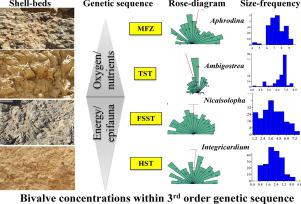当前位置:
X-MOL 学术
›
Sediment. Geol.
›
论文详情
Our official English website, www.x-mol.net, welcomes your feedback! (Note: you will need to create a separate account there.)
Paleoenvironmental significance of the monospecific biostromes in the Campanian-Maastrichtian Duwi Formation (Eastern Desert, Egypt)
Sedimentary Geology ( IF 2.8 ) Pub Date : 2020-10-01 , DOI: 10.1016/j.sedgeo.2020.105772 Ahmed A. Abdelhady , Barbara Seuss , Franz T. Fürsich , Ahmed Ali , Khalaf H.M. Abdel-Raheem , Ramadan S.A. Mohamed
Sedimentary Geology ( IF 2.8 ) Pub Date : 2020-10-01 , DOI: 10.1016/j.sedgeo.2020.105772 Ahmed A. Abdelhady , Barbara Seuss , Franz T. Fürsich , Ahmed Ali , Khalaf H.M. Abdel-Raheem , Ramadan S.A. Mohamed

|
Abstract The Campanian-Maastrichtian Duwi Formation in the Eastern Desert of Egypt is an economic-rich part of the Middle East phosphorite belt, which has been formed during an extensive high-productivity and anoxic episode in the southern Tethys. To understand the consequences of these environmental conditions on the paleo-ecosystems, the sediments and the benthic macrofauna was analyzed. Although the macrobenthic elements are poorly represented throughout the studied sections, four monospecific biostromes were recognized. They included two Ambigostrea oyster biostromes, which have developed under high-energy and fully aerated environments above the storm wave-base. In contrast, the heterodont bivalves Integricardium and Aphrodina biostromes were deposited under mesotrophic, low-energy, and dysoxic regimes. Shell orientation, shell size-frequency, and multivariate analysis of other taphonomic features indicated that one of two Ambigostra biostromes were partially generated by waves and/or storms (i.e. parabiostromes), while the other one is mostly in situ (i.e. autoparabiostromes). In contrast, the heterodont biostromes are intrinsic autochthonous concentrations (autobiostromes). The link between occurrences of biostromes and cyclicity of deposits suggests a clear association to sea-level fluctuations. The autobiostromes dominating the maximum-flooding and early highstand intervals and were differentiated from the parabiostromes, which formed by physical instead of biologic agents during initial transgressions or late highstand. The palaeo-ecosystem was reconstructed and the environmental factors behind the biostromes were identified; the monospecific nature of the biostromes is interpreted to be a consequence of high-stress environment (e.g., high productivity and associated anoxia). The global climate during the Campanian-Maastrichtian, sea level fluctuations, and physiography influenced salinity and oxygen levels and played the pivotal role in the formation of the monospecific biostromes of the Duwi Formation.
中文翻译:

Campanian-Maastrichtian Duwi组(埃及东部沙漠)中单种生物基质的古环境意义
摘要 埃及东部沙漠Campanian-Maastrichtian Duwi组是中东磷矿带中经济丰富的部分,它是在特提斯南部大范围的高生产力和缺氧时期形成的。为了了解这些环境条件对古生态系统的影响,对沉积物和底栖大型动物进行了分析。尽管大型底栖动物元素在整个研究部分的表现不佳,但已识别出四种单一的生物基质。它们包括两个 Ambigostrea 牡蛎生物群落,它们是在风暴波基部上方的高能量和完全通风的环境下形成的。相比之下,异齿类双壳类 Integricardium 和 Aphrodina 生物基质沉积在中营养、低能量和缺氧状态下。壳方向,壳尺寸-频率,和其他埋藏学特征的多变量分析表明,两个 Ambigostra biostromes 之一部分由波浪和/或风暴(即 parabiostromes)产生,而另一个主要是原位(即 autoparabiostromes)。相比之下,异齿生物群落是固有的本土浓度(自体群落)。生物群落的发生与沉积物的周期性之间的联系表明与海平面波动有明显的关联。自生物群在最大洪水和早期高位间隔中占主导地位,并与副生物群不同,后者在初始海侵或晚期高位期间由物理而不是生物制剂形成。重建古生态系统,确定生物群落背后的环境因素;生物基质的单一特性被解释为高压力环境(例如,高生产力和相关缺氧)的结果。Campanian-Maastrichtian 期间的全球气候、海平面波动和地理学影响了盐度和氧含量,并在 Duwi 组单种生物基质的形成中发挥了关键作用。
更新日期:2020-10-01
中文翻译:

Campanian-Maastrichtian Duwi组(埃及东部沙漠)中单种生物基质的古环境意义
摘要 埃及东部沙漠Campanian-Maastrichtian Duwi组是中东磷矿带中经济丰富的部分,它是在特提斯南部大范围的高生产力和缺氧时期形成的。为了了解这些环境条件对古生态系统的影响,对沉积物和底栖大型动物进行了分析。尽管大型底栖动物元素在整个研究部分的表现不佳,但已识别出四种单一的生物基质。它们包括两个 Ambigostrea 牡蛎生物群落,它们是在风暴波基部上方的高能量和完全通风的环境下形成的。相比之下,异齿类双壳类 Integricardium 和 Aphrodina 生物基质沉积在中营养、低能量和缺氧状态下。壳方向,壳尺寸-频率,和其他埋藏学特征的多变量分析表明,两个 Ambigostra biostromes 之一部分由波浪和/或风暴(即 parabiostromes)产生,而另一个主要是原位(即 autoparabiostromes)。相比之下,异齿生物群落是固有的本土浓度(自体群落)。生物群落的发生与沉积物的周期性之间的联系表明与海平面波动有明显的关联。自生物群在最大洪水和早期高位间隔中占主导地位,并与副生物群不同,后者在初始海侵或晚期高位期间由物理而不是生物制剂形成。重建古生态系统,确定生物群落背后的环境因素;生物基质的单一特性被解释为高压力环境(例如,高生产力和相关缺氧)的结果。Campanian-Maastrichtian 期间的全球气候、海平面波动和地理学影响了盐度和氧含量,并在 Duwi 组单种生物基质的形成中发挥了关键作用。


























 京公网安备 11010802027423号
京公网安备 11010802027423号